History of the Vale of Leven Page 4
Page 1 | Page 2 | Page 3 | Page 5
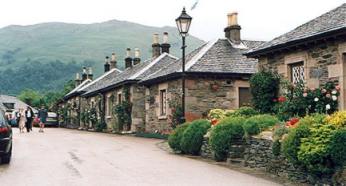
The Village of Luss
While these events were auspicious enough, it is worth remembering that at this time the population of the area was a tiny to-day's standards. A census of 1643
reported 120 communicants in the parish of Bonhill, which would correspond to a population of about 350 people. Including Renton from Cardross parish wouldn't significantly add to that total in the Vale. Of the two other parishes, Luss was probably more populous than Bonhill.
In 1602, just prior to the battle of Glenfruin, the McGregors had raided Glen Finlas (from where the Vale now draws its water). It is recorded that they plundered 45 houses and stole 300 cows, 100 horses 400 sheep and 400 goats. All of these figures are impressive for the time and while the livestock figures are probably exaggerated - they come from the Colquhouns - the number of houses has never been disputed. The 45 houses in 1602 compares with just 2 to day.
Also, we know that in 1688 James II's Chancellor in Scotland in a last desperate act to try to save James's throne, instructed Colquhoun of Luss to send 50 “sturdy Highlanders” to Stirling. This would only be a minority of adult men available - in comparison to the approximately 60 adult men in Bonhill 40 years previously. The Luss men were never sent, by the way. James was in flight just as Colquhoun got the message. It's probably a reasonable speculation that Luss's population was about twice that of Bonhill, while Kilmaronock was probably about the same as the Vale. So at the end of the 17th century there were probably about 1,500 people living in the Vale and on the southern shores of Loch Lomond.
As the 17th century came to an end the area was still very much rural, lightly populated and little involved with  trade. True, trees were being cut down on Loch Lomondside and floated down the Loch and then the Leven for onward shipment to Glasgow building sites (the timbers in Glasgow Cathedral roof had already followed that route). Slate was already being extracted from Luss quarries at Camstradden and stone was being was being shipped out from quarries around Gartocharn, but all of these activities probably employed less than 100 men.
trade. True, trees were being cut down on Loch Lomondside and floated down the Loch and then the Leven for onward shipment to Glasgow building sites (the timbers in Glasgow Cathedral roof had already followed that route). Slate was already being extracted from Luss quarries at Camstradden and stone was being was being shipped out from quarries around Gartocharn, but all of these activities probably employed less than 100 men.
Cattle rearing, dealing and droving were all common in the area and the routes of many of the drove roads were established by this time. The roads themselves were little more than paths or very rough paths, and water-based communications either on the Loch or up and down the Leven were still the preferred means of passenger and much of whatever freight trade there was. All of these activities were essentially rural in nature and made little impact on the social or economic life of the area.
The Lennox Stewarts had departed the scene but other landowners were still in place, and the Smolletts, who purchased the estate of Bonhill in 1684 and moved there from Dumbarton, and styled themselves the Smolletts of Bonhill, joined them in 1684. The estate took the parish, as opposed to the village, name.
None of the Smolletts ever lived in the village of Bonhill. To begin with they lived in Place of Bonhill, which was a house on the west bank of the Leven virtually at the boundary of Bonhill and Cardross parishes. Vale of Leven Academy and St Martins schools now occupy the site and a Place of Bonhill House, latterly occupied by the Flowers family, stood there until the late 1950's when it was demolished to make way for the schools. James Smollett also bought Dalquhurn in 1692, and it was in that house - the site of which is no longer certain - that Tobias Smollett, the novelist, was born in 1721 to Archibald a son of James.
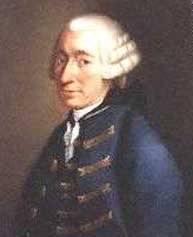
Tobias Smollett
James frequently represented Dumbarton Burghs in the Scottish Parliament, and was one of Burns's “Parcel of Rogues” being a strong advocate of the Union of the Scottish parliament with the English one. No doubt as a reward he was one of the Commissioners appointed in 1707 to frame the articles of Union, and duly took his place as the first MP for Dumbarton District of Burghs in the British Parliament.
His great grandson, Alexander Telfer Smollett, married Cecilia Renton and Alexander's mother, Jane Telfer Smollett, called the village which she had established on her land to house the growing population, Renton, after her son-in-law. It could have been a lot worse. Imagine anyone from Renton having to admit that they came from Cecilia.
The other Dumbartonshire representative in the Scottish parliament at this time was Sir Humphrey Colquhoun - we have already met him as the last of the true Colquhoun line. He is also worth mentioning again as most definitely not one of the Parcel of Rogues. He was passionately opposed to the Union of Parliaments. Although we will return to political reform below, it is worth saying that the elections for either of these 2 gentlemen would be participated in by an electorate of no more than 200 or so voters (they represented 2 quite different seats).
By the early 1700's the issues, which had convulsed rural Scotland for almost a century, now looked resolved to most lowland Scots satisfaction. William and Mary had restored a Presbyterianism without bishops, and while probably the majority of Scots wouldn't have voted for a union of the Parliaments, firstly, they didn't get the opportunity, and secondly, they were prepared to give it a chance to see if the promised increased prosperity was delivered. A period of quiet stability looked to have set in. That was not the view of the Highlanders of course, and when the Hanoverians - German protestants with a faintish Stuart blood-line - were installed on the British throne on the death of Queen Anne, Mary's younger sister, in 1714, matters quickly came to a head for many Highlanders and  Scottish Episcopalians. They remained loyal to the Stuarts, and indeed Prince James Edward (the Old Pretender) had much better claim to the British throne than the Hanoverian George I, who was 59th in the line of succession.
Scottish Episcopalians. They remained loyal to the Stuarts, and indeed Prince James Edward (the Old Pretender) had much better claim to the British throne than the Hanoverian George I, who was 59th in the line of succession.
His Catholicism was undoubtedly a major stumbling block, but many of the Highlanders were Catholic, and also the clan system based as it was on loyalty to the chief superseded religion. Also, by this time it was clear that the Act of Union of 1707 was being widely disregarded by the English, and this particularly alienated a large part of the aristocracy who were always sensitive to their own interests. Given the loyalty that many in Scotland still felt to the local laird, the rising in favour of the Old Pretender of 1715, had a far better chance of success than any other Jacobite rising including the '45 (the name Jacobite had been in use since around 1689 to describe anyone who supported James VII or II).
Most of central and southwest Scotland did not support the Jacobites, but of course this area was right on the boundary of one clan who most certainly did - the McGregors. Rob Roy was already a well-kent figure in the area - and to the Government. He was born on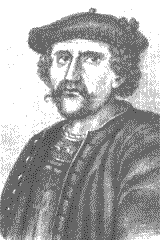 the north-east shore of Loch Katrine in 1671, and he became a prosperous and respected cattle dealer and drover, who was doing very well until his head drover absconded with monies given to Rob Roy by the Duke of Montrose in 1712. The Duke who combined arrogance (no Scottish aristocrat ever went broke from an overdose of arrogance) and stupidity in equal measure, foolishly started a “police action “ campaign against Rob Roy which lasted for many years, and which helped to forge the reputation as a sort of Scottish Robin Hood which history has bestowed on Rob Roy.
the north-east shore of Loch Katrine in 1671, and he became a prosperous and respected cattle dealer and drover, who was doing very well until his head drover absconded with monies given to Rob Roy by the Duke of Montrose in 1712. The Duke who combined arrogance (no Scottish aristocrat ever went broke from an overdose of arrogance) and stupidity in equal measure, foolishly started a “police action “ campaign against Rob Roy which lasted for many years, and which helped to forge the reputation as a sort of Scottish Robin Hood which history has bestowed on Rob Roy.
Rob Roy was no stranger to this area. From his youth onwards he went with other members of the clan on an annual trip to Glasgow to trade and meet friends and relations. Invariably that trip took him from Inversnaid - his home was in the hills above Inversnaid at Craigroyston - down the Loch and the Leven, and then up the Clyde to Glasgow. His days as a cattle-stealer and member of the Watch (a protection racket aimed at lowland farmers who were thus blackmailed into letting the McGregors and others “guard” their livestock) also made him familiar with the Loch side and the islands.
His and the McGregor clan's loyalty to the Stuart cause was never in doubt. Charles II lifted the proscription of the Clan, which was introduced in the wake of the Battle of Glenfruin in 1603, in 1660 because of their continued support for the Stuarts. In 1689 when the Stuarts were again in trouble, Rob Roy himself, then aged 28, fought for the victorious Bonnie Dundee's army at Killiekrankie. So when the 1715 uprising got under way, its no surprise to find Rob Roy involved. This time virtually on his home territory.
Both sides well understood the importance of north-south passage offered by the Loch and the narrow strip of hills on its western side, and the Vale - and also the east-west access to central Scotland from the Leven crossings. It was rumoured Price James Edward himself - the Old Pretender - would land on the north bank of the Clyde somewhere between Dumbarton and the mouth of the Gareloch and make his way into the Lennox and on to his forces in the Perth - Stirling area, ready to attack the Duke of Argyll who was holding Stirling Castle for George I. (Typically for the Jacobite management of the 15 rising, he landed just before Christmas at Peterhead and left a few months later from Montrose. The nearest he got to Loch Lomond was Perth).
To deny the Loch to the Hanoverians, and perhaps to keep easy passage open for the Old Pretender, on September 29th 1715, just after the Earl of Mar had proclaimed James Edward as king, a the of McGregors launched raids into the Lennox. Some headed overland via Drymen to Callander, while a large party came down the Loch. They raided Luss and took all the boats they could find on both sides of the Loch and on the Endrick.
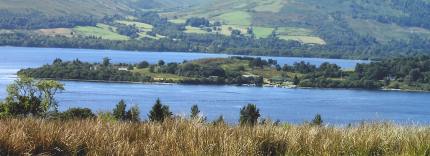
Inchmurrin Island on Loch Lomond
After encamping on Inchmurrin with all their booty they headed off again, by night, for the Leven and landed near Bonhill, exactly where we don't know. There is no record of them doing any pillaging in the Vale. That could of course because by then their presence was known and the populace well warned; it could equally be that there was very little to pillage anyway. Nor is there any record of them bothering the Smolletts property at the Place of Bonhill - on the face of it a natural target as the home of representatives of the Hanoverian government, so perhaps they did not come that far down the Leven. In any event, they retreated via Inchmurrin to Inversnaid over the next day or so, taking the boats, cattle and deer, which they had “liberated” from government supporters.
This was a bold and innovative attack, featuring as it did what is still the only water-based military campaign to take place in modern inland Britain. No lives were lost, much booty was gained - particularly at the expense of the hated Duke of Montrose, and it was potentially an important victory for the Jacobites - it certainly threatened government lines of communications and potentially exposed Argyll's western flank at Stirling. The government couldn't ignore it, and its response was quick and unusually competent for the time.
Based at Dumbarton, what we would now call a combined operations force from the various navy, army and volunteer forces at its disposal on and around the Clyde was put together within a couple of days. This motley force set out on what was known as The Loch Lomond Expedition. The expeditionary forces included hundreds of volunteers from Clydeside, about 100 sailors from Royal Navy ships stationed on the Clyde, in 4 pinnacles and 3 long boats from these ships, a gun ship from Port Glasgow, and large boats from Dumbarton, as well as a number of guns of various types and calibre.
The 11 boats were drawn up the Leven. As many men as possible embarked on them at the mouth of the Leven and set sail for McGregor country, while the rest set out to march up the west bank of the Loch - followed, not led, by the gentry of the area. In total a force of about 400 men sailed and marched off to settle the score with the McGregors.
All spent the night at Luss where they were joined by Colquhoun of Luss and 50 (that 50 again) of his men. It appears that overnight in the camp, demoralising rumours about the strength of the opposing McGregor forces to say nothing of their barbarism were spread. 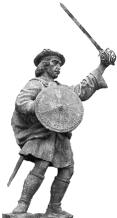 The men were not demoralised, but they were wisely cautious. The hills and glens of the Lochside above Inversnaid very much favours the defenders from any attack coming from either the Loch or the western shore, and the this was abundantly clear to the expeditionary forces. So when they got to Inversnaid the next day, they fired a few canon shots at a couple of cottages on the hillside. The shots damaged the roofs of the cottages and out came a couple of old women who hurled Gaelic abuse and curses down on them.
The men were not demoralised, but they were wisely cautious. The hills and glens of the Lochside above Inversnaid very much favours the defenders from any attack coming from either the Loch or the western shore, and the this was abundantly clear to the expeditionary forces. So when they got to Inversnaid the next day, they fired a few canon shots at a couple of cottages on the hillside. The shots damaged the roofs of the cottages and out came a couple of old women who hurled Gaelic abuse and curses down on them.
When it was clear that there were no McGregor forces in the area, about 100 men landed and marched up the hill to the area of where Garrison of Inversnaid now is, where they paraded for about an hour with drums beating and shouting challenges to the absent McGregors. They then very wisely departed back down the Loch before any McGregors arrived. No casualties again, but they had invaded McGregor territory, and an early spin doctor working on the government's behalf, quickly wrote a pamphlet, which was widely circulated, describing the Loch Lomond expedition as a famous victory which cowed the McGregors into flight. The pamphleteer exaggerated of course, but perhaps not by much.
Rob Roy was absent during the Expedition, but where was he? He may have gone northeast to Strathfillan to join Highlanders heading to-wards Stirling, he may have gone directly to the Stirling area. In any event he seems to have turned up to “watch” the Battle of Sherriffmuir in November 1715. He turned to be a very careful calculator of the odds in battle, and his approach is best summed up as “if they can't without us, they certainly won't win with us. Anyway, he was back in action raiding on the Lochside in December 1715, but that seems to have been straightforward cattle-stealing rather than military action and when a second expeditionary force was sent against him, at the behest of the Duke of Montrose, he quickly fled, only just escaping capture in Glen Falloch.
The 15 rising finished with the Battle of Sherriffmuir, and Rob Roy was on the losing side. However, being the essentially cautious, shrewd person he was, he surrender to and placed himself under the protection of a Campbell of Fonab, a close aide of the Duke of Argyll and escaped any harsh punishment. This left him more or less free to continue his personal feud with the Duke of Montrose from whom he continued to steal livestock and cattle, and to humiliate those who worked for the Duke.
One of the better-known incidents was his abduction of the Duke's factor, John Graham of Killearn. Montrose had been responsible for harrying Rob Roy for years - troops had twice burned down his house at Craigroyston, and another in Glen Dochart. Graham had been present at one of the house burnings.
At Gartmore in November 1716, Rob Roy abducted Graham and imprisoned him on an island on Loch Katrine at Stronachlachar pier, now known as the factor's island. He was freed after a few weeks but the moral victory was Rob Roy's as was the rent monies which he took from Graham. His last appearance on the military scene was in the Jacobite incursion of 1719, at Lochshiel, a long way to the north of his home territory on the Lochside. Applying his customary military caution, he managed to wriggle his way out of that fiasco too with no serious repercussions.
Page 1 | Page 2 | Page 3 | Page 5


